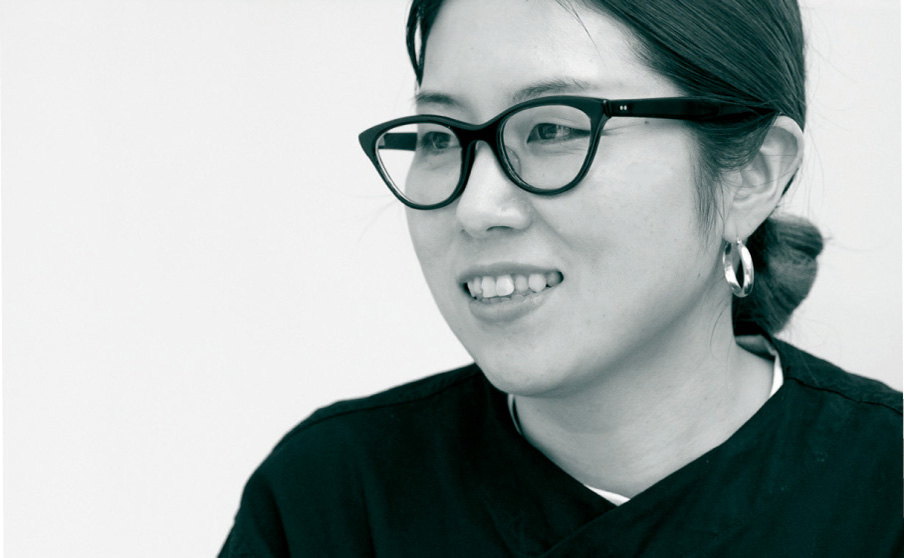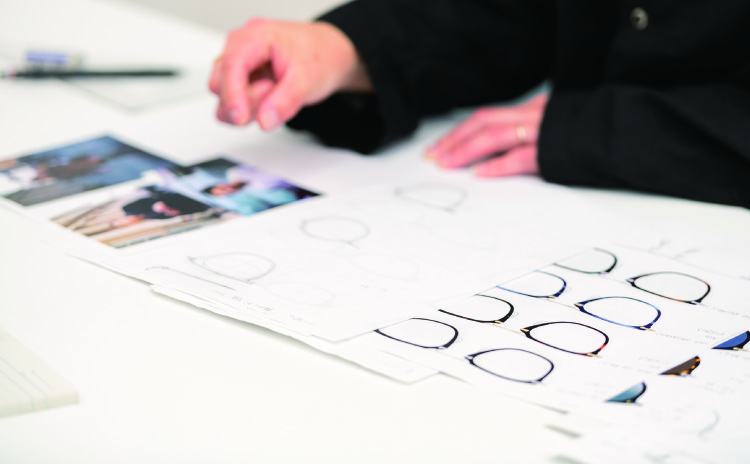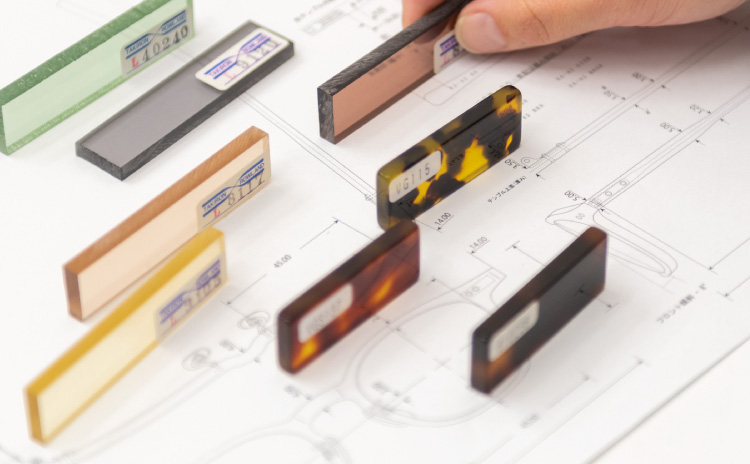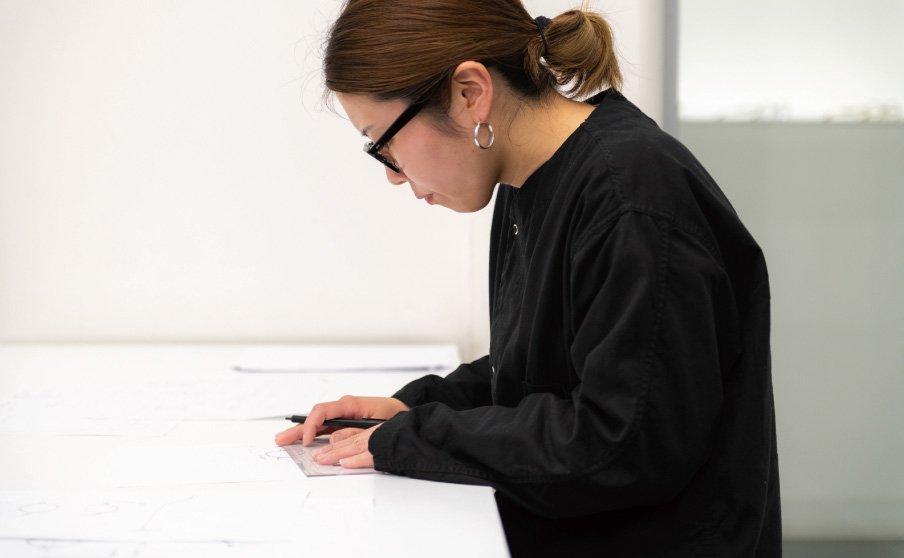
One doesn't notice it when seen from inside, but there's a "true value" to things that stands out as soon as they're seen from outside. For example, I sometimes only notice the appeal of the town where I was born and raised when I go away from it. Tools are the same way. Only when it leaves our hands do we notice the importance of a tool we take for granted when using it daily. To Chief Designer Kanako Yano of the Kaneko Optical's BACKSTAGE in-house factory, that's what "Japanese monozukuri" is all about.
"During college, I lived for a time as a foreign exchange student in New York, where I felt deeply the power of the traditional manual work and resulting products she had grown up with in my life in Japan. To be honest I never gave these things a thought when I was in Japan -- and I think that may apply to many Japanese who have studied abroad. My feeling of wanting to become involved in Japanese monozukuri and communicate its excellence to people in Japan and abroad began to grow. Right around that time, I learned about Sabae as a center for the production of eyeglasses."
Today Yano has established herself as a designer at the center of traditional monozukuri, in the eyeglass-making city of Sabae. Now in her 13th year, she sees it as "the place of my dreams. Once I entered this world, it was an even happier place than I'd imagined. I always loved to draw designs, and now that has become my job, and things I've drawn because I thought they were good have become products. I'm not exaggerating; this job is like a dream."
What is important is who uses it.
After graduating from high school near her hometown of Osaka, Yano entered Kyoto Seika University, where she majored in printmaking. There she learned more about the pursuit of self-expression than mainstream design. The main focus was two-dimensional expression through media such as commercial paintings and posters. That school placed top priority on originality, and evaluated students based on "who has the most interesting work?" – which is the opposite of what the public generally looks for in design. There she established his own basis for creativity and threw herself into study and creation. As mentioned earlier, she became impressed with Japan's monozukuri culture through an experience during her junior year abroad, and decided to join Kaneko Optical. For Yano, the BACKSTAGE monozukuri site was an ideal environment where she knew she could throw herself seriously into her work.
People use the general term "eyewear design," but the job covers a wide scope, including everything from product concept to overall frame 玉型?(spherical type) design on the one hand, to design of individual parts, such as temples, bridges, rivets, and ornamentation on the other. Whatever the design job, we don't think about glasses on their own. What's important is to imagine what kind of person is going to put those glasses on in the store.
"Since I was a kid, I've had the habit of observing people. Looking at people on the street, I would obsess, 'what kind of job does this person do, what kind of life, what kind of experience led them to choose those clothes, those glasses, that bag, or those shoes?' These are sources for the images of subjects I portray in my mind as I think about eyeglass designs." Yano always has at her fingertips a file of photographs of people in different colored clothing, in suit style, street style, etc. so she can superimpose images of glasses she's designed onto the face portion of the subject and get a feel for the overall look. The eyeglasses don't stand alone – they are clearly coordinated with other elements of dress as part of the tools for daily living, and can be further refined by viewing them from distance.
"Of course I can sense the feeling of the times and read the trends, but I'm always conscious of maintaining a sense of balance so I don't become biased. I position myself within that framework and see my work as a designer as adding newness and ease of use. Designs are almost never born complete, and floundering about is a given. When I'm asked if I ever have slumps, I tell people I've been in a continuous slump (laughs). And although it's difficult to put into words, there's an instant when the thing I've been designing can be unreservedly perceived as 'good.' A design like that still looks good the next day, and the day after that. And when I show it to people around me, they tell me it's good too. I think these are the ones so many customers pick when they become products."
Searching for the ideal "normal."
Yano-san characterizes herself as having "straight-out plebian taste." But that is an important factor that she cannot lose, both as a person and as a designer. "When you work as a designer, it's hard to avoid your ego and desire to be cool, or to make something innovative that surpasses the existing standard. But I want to avoid those temptations, and always keep my feet on the ground. To me, the eyeglasses born out of that plebian, universal sensibility are more attractive."
"Kaneko Optical benefits from all the wisdom nurtured over generations in Sabae. Our predecessors applied that wisdom to leave us a large legacy of their work. For me, that is the most important textbook I have. With that textbook, I aim for a simplicity that projects the excellence of the object. To me, eyeglasses that people think are 'normal' on the wearer are the height of good design, because they draw people to look at their true nature. I sometimes want to try on eyeglasses or clothes with a different look from usual, but there's a 'normal' within us that we always come back to, right? As a designer, if I can keep coming up with designs that fit what people see as their own 'normal,' that's ideal."
Making something out of nothing. Being a professional designer means not being able to escape the pain of that birthing. But beyond that pain, there is no greater joy than giving birth to a design. Yano feels it each time she puts her sketching pen to paper.
PROFILE
Kanako Yano
Born in Osaka. Graduated from the Department of Printmaking, Faculty of Arts, Kyoto Seika University. At university, she devoted herself to creating art while learning modes of art expression using primarily paper materials and steadily refined her design skills. She was also an exchange student in New York, where she learned the essentials of Japan's monozukuri culture as seen from other countries, and she gradually became interested in Japanese traditional industries. Upon graduation she joined Kaneko Optical, where she has been building her career as a designer, working in the planning and design office of the BACKSTAGE company factory.




"During college, I lived for a time as a foreign exchange student in New York, where I felt deeply the power of the traditional manual work and resulting products she had grown up with in my life in Japan. To be honest I never gave these things a thought when I was in Japan -- and I think that may apply to many Japanese who have studied abroad. My feeling of wanting to become involved in Japanese monozukuri and communicate its excellence to people in Japan and abroad began to grow. Right around that time, I learned about Sabae as a center for the production of eyeglasses."
Today Yano has established herself as a designer at the center of traditional monozukuri, in the eyeglass-making city of Sabae. Now in her 13th year, she sees it as "the place of my dreams. Once I entered this world, it was an even happier place than I'd imagined. I always loved to draw designs, and now that has become my job, and things I've drawn because I thought they were good have become products. I'm not exaggerating; this job is like a dream."